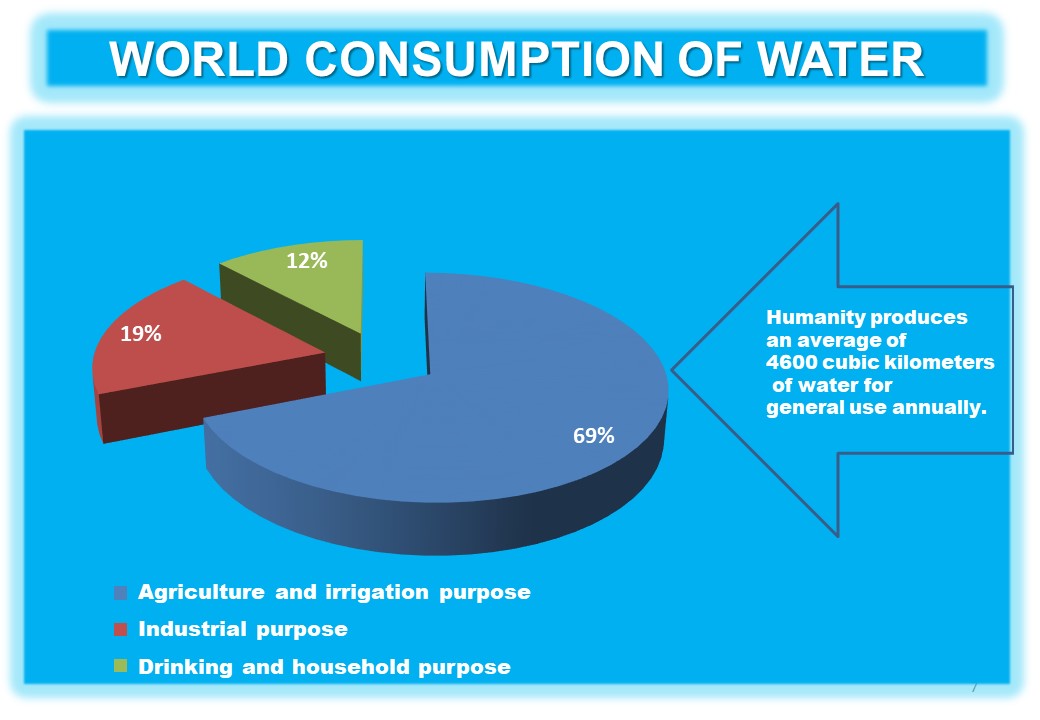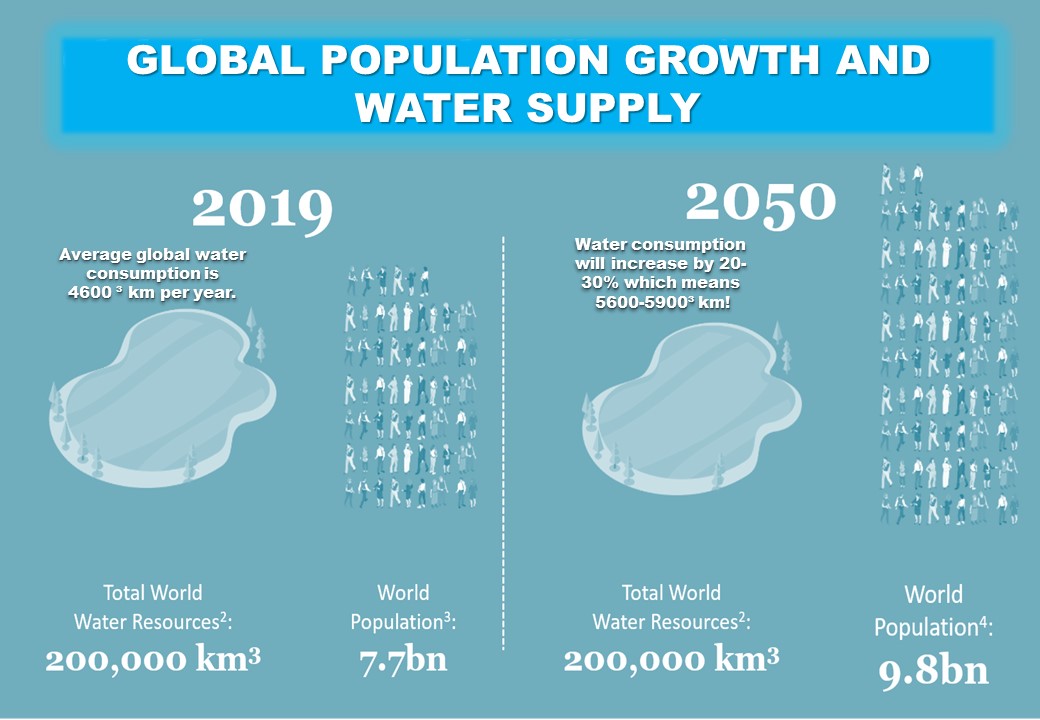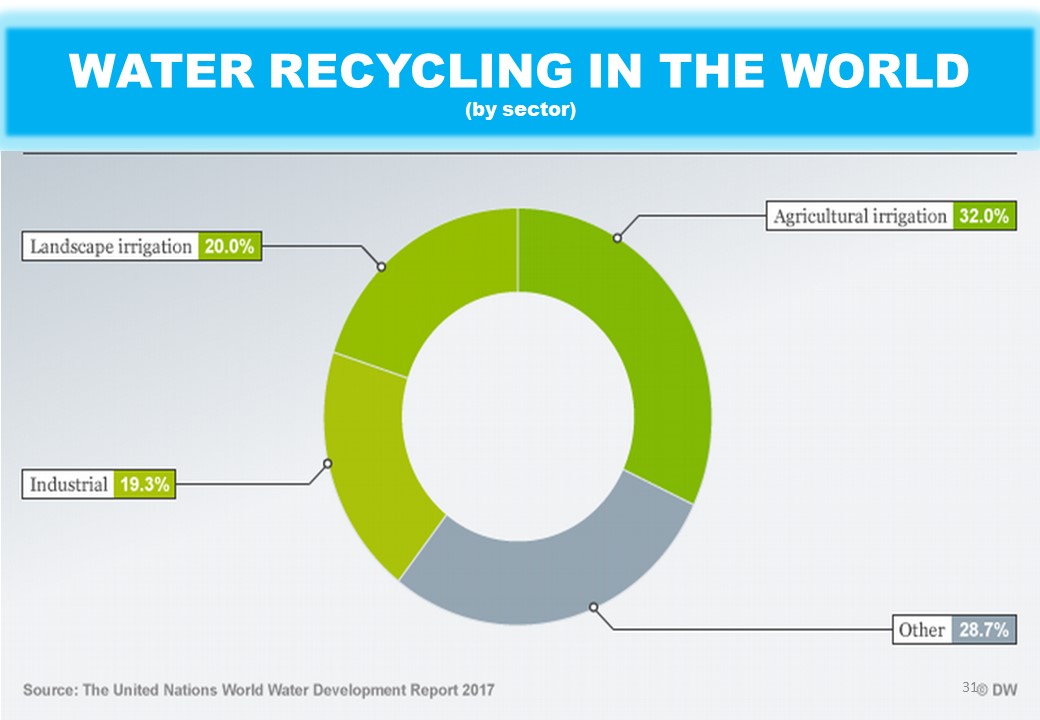Water covers about 71% of the surface of our mother earth. However, only 2.5% of all water on the planet is freshwater, of which only about 31 percent is accessible for human uses due to geographical and seasonal variations and the rest is trapped in glaciers and snowfields. Today, on a global scale, the annual withdrawal amount in total for human uses is over 4600 cubic meters, of which 69 percent is only for irrigation. Withdrawals for industry are 19 percent, and those for municipal use are about 12 percent.

Rates of global freshwater use have been increasing sharply driven by a combination of factors like rapid population growth, urbanization, and climate change. It is projected that the world population in 2050 will be around 9.8 billion which will increase the global water demand at a similar rate until 2050, accounting for an increase of 20 to 30% above the current level of water use (United Nations, 2019). The rate of growth in industrialized countries is well under one percent per year. In developing countries, however, the growth rate exceeds two percent per year, and in some parts of Africa, Asia, and the Middle East it exceeds three percent per year. As a result, over 90 percent of all future population increases will occur in the developing world (United Nations, 2003).
Urbanization, another major factor, intensifies the pressures of population growth on water resources due to imbalances between water demands and the proximity of water sources leading more countries to water scarcity in the coming decade. While News York was the only city in the world with a population of more than 10 million in 1950, the number increased to 45 in 2019. The number of the global urban population reached 4.2 billion in 2019 and the overall growth of the world’s population could add another 2 more billion people to urban areas by 2050.

If water demand continues to increase at this rate due to the above-mentioned and other factors, 45 percent of the global gross domestic product (also known as Gross World Product, the total of all countries’ GDPs), 52 percent of the world’s population and 40 percent of global grain production will be at risk by 2050 which means the global community is facing a major challenge to manage water resources efficiently.

According to the United Nations Food and Agriculture Organization, water stress starts when the water available in a country drops below 1 700 m3/year or 4 600 liters/day per person. When the 1 000 m3/year or about 2 700 liters/day per person threshold is crossed, water scarcity is experienced. Absolute water scarcity is considered for countries with less 500 m3/year or roughly 1 400 liters/day per person. By this definition, 49 countries are water-stressed globally, 9 of which experience water scarcity and 21 absolute water scarcity. This situation is expected to continue globally, badly affecting developing countries.

Water scarce countries can expect to experience chronic and widespread shortages of water that hinder their development and welfare. Globally, water scarcity is resulting in a host of crises, such as food shortages, regional water conflicts, limited economic development, and environmental degradation (Postel, 2000). Therefore, these issues have put freshwater availability at the forefront of state, national, and international efforts in recent decades. One of the potential solutions to these issues is a sustainable water resources management and water reuse is one of the approaches of the sustainable management.

In other words, encouraging the use of treated wastewater and reducing high-quality potable water use for non-potable applications is widely recognized as an effective form in sustainable water resources management and water reuse. It is becoming a big trend towards sustainable growth throughout the world.

Water reuse: Chronology
3000 BC Crete, Greece – Minoan civilization: use of wastewater for agricultural irrigation
97 AD Rome Italy – The City of Rome has a water supply commissioner, Sexus Julius Frontilus.
1500, 1700 Germany, United Kingdom – Sewage farms are used for wastewater disposal
1800-1850 France, England, United States – Legal use of sewers for human waste disposal in Paris (1880), London (1815), and Boston (1833) instituted.
1875-1900 France, England – Microbial pollution of water demonstrated by Pasteur. Sodium hypochlorite disinfection by Down to render “pure and wholesome” advocated.
1890 Mexico City, Mexico – Drainage canals are built to take untreated wastewater to irrigate an important agricultural area north of the city, a practice that still continues today. Untreated or minimally treated wastewater from Mexico City is delivered to the Valley of Mexico where it is used to irrigate about 90,000 ha of agricultural lands, including vegetables.
1906 Jersey City, NJ, U.S – Chlorination of water supply.
1926 United States – In Grand Canyon National Park treated wastewater is first used in a dual water system for toilet flushing, lawn sprinkling, cooling water, and boiler feedwater.
1955 Japan – Industrial water is supplied from the Mikawajima wastewater treatment plant by Tokyo Metropolitan Sewerage Bureau.
1968 Namibia – Direct potable reuse began at Windhoek’s Goreangab Water Reclamation Plant.
2000s Singapore - The first NEWater plant was launched. NEWater is the brand name given to reclaimed water produced by Singapore's Public Utilities Board. More specifically, it is treated wastewater (sewage) that has been purified using dual-membrane (microfiltration and reverse osmosis) and ultraviolet technologies, in addition to conventional water treatment processes. The water is potable and is consumed by humans. Today, there five NEWater plants supplying up to 40% of Singapore's current water needs. By 2060, NEWater is expected to meet up to 55% of Singapore's future water demand.

